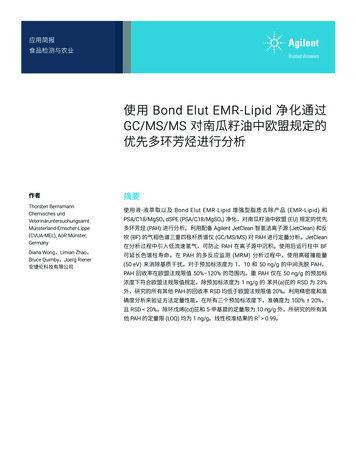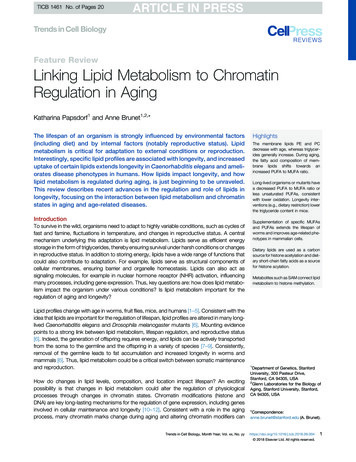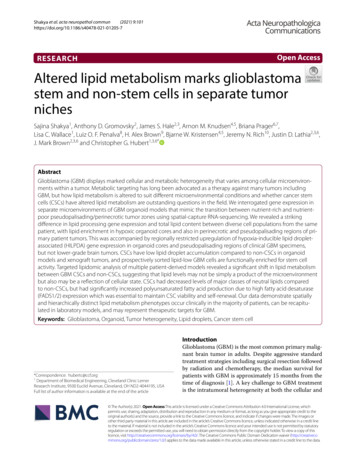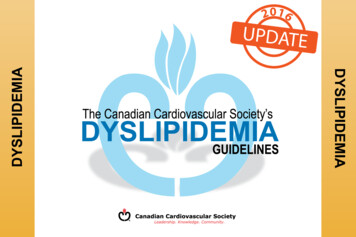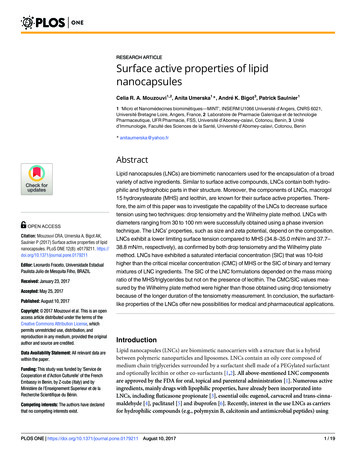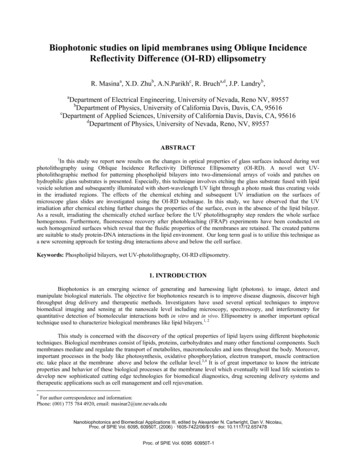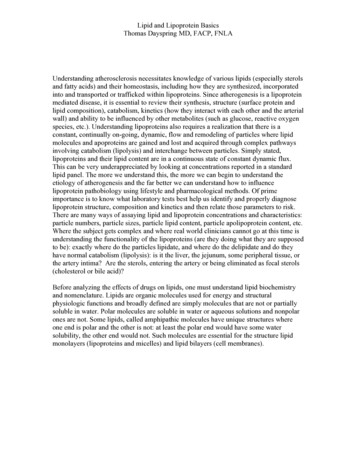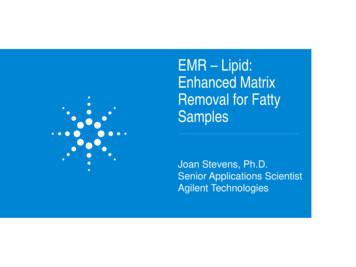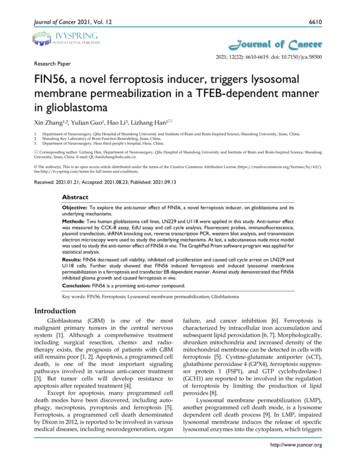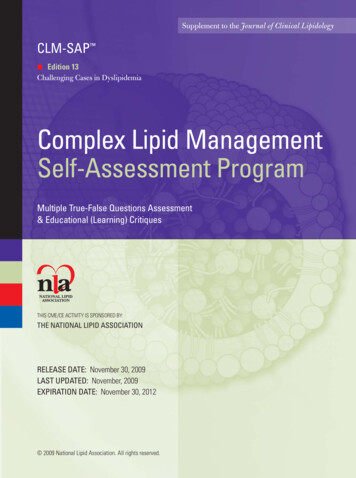
Transcription
Supplement to the Journal of Clinical LipidologyCLM-SAP Edition 13Challenging Cases in DyslipidemiaComplex Lipid ManagementSelf-Assessment ProgramMultiple True-False Questions Assessment& Educational (Learning) CritiquesTHIS CME/CE ACTIVITY IS SPONSORED BY:THE NATIONAL LIPID ASSOCIATIONRELEASE DATE: November 30, 2009LAST UPDATED: November, 2009EXPIRATION DATE: November 30, 2012 2009 National Lipid Association. All rights reserved.
Cover Illustration: HDL CholesterolDeveloped by: Professional Evaluation, Inc.Developing Medical Specialty Board Category 1 CME Programs for Over Three DecadesProfessional Evaluation Inc.4 Midland Avenue, Suite 105, Berwyn, PA 19312-1687 www.proevalinc.com
Complex Lipid ManagementSelf-Assessment Program (CLM-SAP )TM Edition 13, Complex Cases in DyslipidemiaTarget Audience:Clinical Lipidologists, Cardiologists, Endocrinologists, Nephrologists, Primary Care Physicians, General Internists,Family Practitioners, Ph.D.s, Cardiovascular Nurses, Pharmacists, Physician Assistants, and Registered Dietitians.Release Date: November 30, 2009The opinions or views expressed in this publication are those of the program faculty and do not necessarily reflect theopinions or recommendations of the National Lipid Association, AKH Inc., or the commercial supporters. The faculty mayhave included discussion on unlabeled uses of a commercial product or an investigational use of a product not yet approvedfor this purpose. Please consult the full prescribing information before using any medication mentioned in this publication.Expiration Date: November 30, 2012The estimated time for completion of this activity is 2.5 hours. There is no fee to participate and receive credit.This CME activity was planned and produced in accordance with ACCME Standards.Table of Contents2General Instructions3Educational Objectives4Accreditation4Program Faculty5Disclosure Statement6Multiple Choice Questions (MCQs)14Appendices:14I. Normal laboratory values15II. List of abbreviations16III. Cholesterol- and lipid-lowering drug classes and generic/trade names17Educational Critiques27Computer-scored Answer Sheet28Program Evaluation Questions
Dear Healthcare Professional:You are invited to participate in the Complex Lipid Management Self-Assessment Program (CLM-SAP ) SeriesEdition 13, Challenging Cases in Dyslipidemia. Edition 13 of CLM-SAP is part of a series designed to help youstrengthen and reinforce your knowledge of clinical lipidology.Edition 13 of CLM-SAP is sponsored by the National Lipid Association (NLA) for up to 2.5 AMA PRA Category 1Credits and by AKH Inc., Advancing Knowledge in Healthcare for Continuing Education Credit. The credits earnedcan be applied toward meeting the requirements necessary to be eligible for the American Board of Clinical Lipidology(ABCL) and the Accreditation Council for Clinical Lipidology (ACCL) Certifying Examinations.This CLM-SAP was designed with medical specialty board technology to assess and strengthen your knowledgeand provide you with an in-depth learning experience towards better understanding the options available formanaging patients with complex dyslipidemia. The multiple true-false question component of the CLM-SAP wasdeveloped at the upper level of difficulty similar in type and format to a board certifying examination. Once you haveproperly completed Edition 13 in its entirety (see General Instructions below), your knowledge and competencyin the management of patients with complex dyslipidemia will be strengthened.General Instructions for Completion of CLM-SAPEdition 13 of CLM-SAP consists of the following components: Multiple True-False Questions (MCQs) Assessment ComponentThis consists of 20 multiple true-false MCQs (Items) which require that you respond either T (true) or F (false) toeach of the three, four, or five lettered options for each item. Appendices I through III on pages 14–16 are relevantto completion of the MCQs. Computer-Scored Answer SheetThis is located on page 27. Please detach it along the perforation. Your selection of either TRUE or FALSEfor each lettered option in each Item is to be marked on the answer sheet adjacent to the number for that Item.Please refer to the sample for how to mark your answers on the answer sheet.2Complex Lipid Management Self-Assessment Program
Educational (Learning) Critiques ComponentTO MAXIMIZE YOUR LEARNING EXPERIENCE IT IS IMPORTANT THAT YOU DO NOT LOOKAT THE EDUCATIONAL CRITIQUES COMPONENT UNTIL AFTER YOU HAVE COMPLETEDMARKING YOUR ANSWERS FOR THE MCQs ON THE ANSWER SHEET. The critiques componentcontains detailed explanations for the correct and incorrect answers for the MCQs based on the most currentpeer-reviewed published information. Once you have read the Educational Critiques, the bibliographic referencesshould be utilized as follow-up study for those MCQs that you answered incorrectly. The critiques are the teachingand learning component of CLM-SAP. They are to be used in combination with the MCQ assessment componentto provide you with a positive, active learning experience.DO NOT CHANGE THE ANSWERS MARKED ON YOUR ANSWER SHEET WHILE READING THECRITIQUES. THE INTENT OF CLM-SAP IS LEARNING NEW KNOWLEDGE AND REINFORCINGPREVIOUSLY LEARNED KNOWLEDGE. THERE IS NO PASS-FAIL SCORE. Program Evaluation ComponentAfter you have completed the MCQ and Critique components as instructed on page 2, turn to the reverse sideof your computer-scored answer sheet. Please select the one lettered option that BEST answers each programevaluation question and mark it on the answer sheet. Then indicate the number of hours for which you are claimingCME or CE credit, and sign the form.NoteAfter you have completed sections A and B of the answer sheet, it is important that you return it to theNational Lipid Association (NLA) by Fax to: 904.998.0855 or Mail to: NLA, 6816 Southpoint Parkway, #1000,Jacksonville, FL 32216. To receive a statement of credit from the NLA for up to 2.5 AMA PRA Category 1 Credits or from AKH Inc. for continuing education credit, you must return your completed answer sheet and signedprogram evaluation form. PLEASE ALLOW 6–8 WEEKS FOR RECEIPT OF YOUR STATEMENT OFPARTICIPATION. In addition, by returning your completed answer sheet, your participation will be documentedfor future certification purposes.Educational ObjectivesAfter completing this enduring materials CME/CE activity, you will be better able to: Manage complex cases of dyslipidemia including a patient with severe hypertriglyceridemia; a patient withtendon xanthomas but no family history of heart disease; a low risk patient with elevated hs-CRP; a patient withstatin intolerance; a patient with normal lipid profile but with a strong family history of premature CHD; anda patient with recent acute coronary syndrome and metabolic syndrome. Discuss the etiology of various types of complex dyslipidemia and the role of biomarkers. Recognize gene variations associated with complex dyslipidemia.Complex Lipid Management Self-Assessment Program3
AccreditationPhysicians: The National Lipid Association (NLA) is accredited by the Accreditation Council for Continuing MedicalEducation (ACCME) to provide continuing medical education for physicians.The NLA designates this educational activity for a maximum of 2.5 AMA PRA Category 1 Credits .Physicians should only claim credit commensurate with the extent of their participation in the activity.Nurses: AKH Inc. is accredited as a provider of continuing nursing education by the American Nurses CredentialingCenter’s COA.AKH Inc. designates this educational activity for 2.5 contact hours (0.25 CEU). Accreditation applies solely toeducational activities and does not imply approval or endorsement of any commercial product by the ANCC-COA.Dietitians: AKH Inc. is a Continuing Professional Education (CPE) Accredited Provider with the Commissionon Dietetic Registration (CDR). Registered dietitians (RDs) and dietetic technicians, registered (DTRs) will receive2.5 continuing professional education units (CPEUs) for completion of this program/material. Provider #AN008.The focus of this activity is rated Level 3. Learners may submit evaluations of program/materials quality to the CDRat www.cdnet.org.Pharmacists: AKH Inc. is accredited by the Accreditation Council for Pharmacy Education as a providerof continuing pharmacy education. AKH Inc. approves this application-based activity for 2.5 hours(.25 CEU). UAN 077-9999-09-051-H01-P.Program Faculty Faculty Michael H. Davidson, M.D., FACC, FACP, FNLAClinical ProfessorDirector of Preventive CardiologyPritzker School of MedicineThe University of ChicagoExecutive Medical DirectorRadiant ResearchChicago, ILCarl E. Orringer, M.D., FACC, FAHA, FNLAHarrington-McLaughlin Chairin Preventive Cardiovascular MedicineDirector of Preventive Cardiovascular MedicineUniversity Hospitals Case Medical CenterAssociate Professor of MedicineCase Western Reserve University School of MedicineCleveland, OH NLA Peer ReviewerChief Editor and PublisherDante S. LaRocca, Ph.DPresidentProfessional Evaluation, Inc.Ambler, PAAcknowledgementsSpecial thanks for the invaluable assistance provided by Ms. Devon Happersett-Heppe,and Mr. Marc Heppe towards the development of this program.4Complex Lipid Management Self-Assessment Program
NLA Disclosure PolicyIn accordance with the ACCME Standards for Commercial Support, ACPE, ANCC, and CDR policies and standardsand the policy of the NLA, any faculty relationship with the manufacturer(s) of any commercial product(s) discussedin this educational activity, which in the context of their presentation could be perceived as a real or apparent conflictof interest (e.g., ownership of stock, honoraria, research grants, or consulting fees), is disclosed below.NLA and AKH staff planners and reviewers have no relevant financial interests to disclose.Michael H. Davidson, M.D., FACC, FACPAdvisory Board: Abbott Laboratories, Inc., AstraZeneca, Daiichi Sankyo, Inc., GlaxoSmithKline, Kinemed,Merck & Co., Merck/Schering-Plough Pharmaceuticals, Roche Pharmaceuticals, Takeda Pharmaceuticals.Board of Directors: Omthera, Professional Evaluation, Inc. Medical Education Company, Sonogene.Consultant: Abbott Laboratories, Inc., AcademicCME, AstraZeneca, Daiichi Sankyo, Inc., diaDexus, GlaxoSmithKline,Kinemed, LipoScience, Merck & Co., Merck/Schering-Plough Pharmaceuticals, Omthera, Professional Evaluation, Inc.,Roche Pharmaceuticals, sanofi-aventis, Synarc, Takeda Pharmaceuticals, Vindico.Research Support: Abbott Laboratories, Inc., AstraZeneca, Merck & Co., Merck/Schering-Plough Pharmaceuticals,Roche Pharmaceuticals,Takeda Pharmaceuticals.Speaker’s Bureau: Abbott Laboratories, Inc., AstraZeneca, GlaxoSmithKline, Merck & Co., Merck/Schering-PloughPharmaceuticals, Takeda Pharmaceuticals.Carl E. Orringer, M.D., FACC, FAHA, FNLASpeaker’s Bureau: Abbott Laboratories, AstraZeneca, and GlaxoSmithKline.Dante S. LaRocca, Ph.D.None.Unapproved Uses of Drugs/Devices and Financial DisclosuresIn accordance with requirements of the FDA, the audience is advised that information presented in this continuingmedical education activity may contain references to unlabeled or unapproved uses of drugs or devices. Please referto the FDA approved package insert for each drug/device for full prescribing/utilization information.Commercial SupportThis activity is supported by an educational grant from Solvay Pharmaceuticals. It is the policy of the NLA andAKH to adhere to ACCME Essential Areas, Policies and Standards for Commercial Support, and ACPE, ANCC,and CDR standards and policies to ensure fair balance, independence, objectivity, and scientific rigor in allits sponsored activities.Complex Lipid Management Self-Assessment Program5
Complex Lipid Management Self-Assessment Program (CLM-SAP )Multiple True-False Questions (MCQs)Directions1Items 1–20 require that you answer either TRUE or FALSE for each option (A through E)in EACH item by filling in the corresponding circle on the answer sheet found in the back of the book.The sample to the right illustrates how to do this.T FA AB BC CD DE E Items 1–5A Young Woman with Severe HypertriglyceridemiaA 35-year-old woman presents to the lipid clinic upon referral by her OB/GYN physician for evaluation of severehypercholesterolemia. Her past medical history is unremarkable. Both her parents died with premature CHD (fatherage 58 and mother age 57). She is 5’6”, 198 lbs. She had difficulty with fertility and, with therapy, delivered healthytriplets. During pregnancy, she had gestational diabetes. After her pregnancy, she continued to gain a considerableamount of weight and now weighs 60 lbs. more than her pre-pregnancy weight. A lipid profile performed four weeksprior to her visit was total cholesterol 1000 mg/dL (verified by repeat analysis, highest level of detection) and triglycerides (TG) 4544 mg/dL (also verified by repeat measures). HDL and LDL-C were not performed due to the fact thatspecimen was unsuitable for assay due to lipemia. She was placed on fenofibric acid 135 mg and prescription omega-3fatty acids 4 g/day and referred to you for further evaluation. Her repeat lipid profile was as follows:Total CholesterolTriglycerides1277 mg/dLHDL-CN/ALDL-CN/AGlucose6643 mg/dL108 mg/dLAST23 u/L (N 10–30 u/L)ALT30 u/L (N 6–40 u/L)Complex Lipid Management Self-Assessment Program — MCQs
1.2.Which of the following physical findings depicted in photographs A–E is/are consistent with this patient’s medicalhistory and laboratory findings?(A)(B)(D)(E)(C)Which of the following tests is/are appropriate for this patient?(A) Apo E genotype.(B) A1C.(C) Pelvic ultrasound.(D) TSH.(E) C-peptide.Results of the tests were as follows: Apo E genotype — 2:2; A1C — 6.1%; pelvic ultrasound — ovarian cyst;TSH — 2.0 µ/L; and c-peptide — normal.3.Based on all of the information that you now have, which of the following is/are appropriate treatmentsfor this patient?(A) Low glycemic index/low carbohydrate diet.(B) Atorvastatin 40 mg.(C) Metformin.(D) Colesevelam.(E) Niacin.4.She is placed on dietary therapy and 2 medications. She wants to get pregnant. Which of the following medicationswould need to be discontinued?(A) Fenofibrate.(B) Atorvastatin.(C) Metformin.(D) Prescription omega-3.(E) Gemfibrozil.MCQs — Complex Lipid Management Self-Assessment Program7
5.Her husband has a normal lipid profile and his Apo E genotype is 3:3. Which of the following statementsis/are true?(A) The chance their child will have familial dysbetalipoproteinemia is 50%.(B) The American Academy of Pediatrics recommends nutritional therapy with reduced-fat milk at 1 yearfor children at risk owing to obesity or family history.(C) Pregnancy is not associated with an increased risk of pancreatitis in patients with familialdysbetalipoproteinemia.(D) The American Diabetes Association recommends that all pregnant women have a 75 g glucose load oralglucose tolerance test to rule out gestational diabetes.(E) Women with gestational diabetes should be screened for diabetes 6-12 weeks post partum and shouldbe followed up with subsequent screening for the development of diabetes or pre-diabetes. Items 6–7A Patient with Tendon Xanthomas but No Family History of Heart DiseaseA 22-year-old woman is referred to you after having a large tendon xanthoma removed from her wrist. She had a cataractremoved from her left eye two years ago. Both her parents are alive and well with no history of coronary heart disease.6.Which of the following mutations is/are associated with the presence of tendon xanthoma?(A) LDL receptor binding domain abnormality.(B) Apo B R3500Q.(C) PCSK9 upregulation.(D) 7-alpha-hydroxylase deficiency.(E) ABCG8 deficiency.7.Both of her parents have a normal lipid profile. Which of the following genetic diseases is/are possiblein this patient?(A) Autosomal recessive hypercholesterolemia.(B) Familial hypercholesterolemia.(C) Beta sitosterolemia.(D) Cerebrotendinous xanthomatosis (CTX).(E) Familial defective Apo B.8Complex Lipid Management Self-Assessment Program — MCQs
Items 8–10A Relative Low Risk Woman with Elevated hs-CRPA 60-year-old college professor comes to see you for an opinion as to whether she should initiate statin therapy.Her lipid profile is as follows:Total Cholesterol201 mg/dLTriglycerides150 mg/dLHDL45 mg/dLLDL126 mg/dLGlucose99 mg/dLVitals:Blood Pressure120/78 mm HgHeight5’2”Weight130 lbsWaist circumference36”Her father died at age 66 of pancreatic cancer and her mother, age 83, had coronary bypass surgery ten years agoand she has type 2 diabetes mellitus. A brother, age 62, had a stent placed in his left anterior descending artery at age 58.She recently had an hs-CRP of 4.5 mg/L; she takes no medications.8.Regarding the JUPITER trial, which of the following statements is/are true for this patient?(A) She would have qualified for participation.(B) Women did not achieve a significant reduction in the primary endpoint.(C) There was a significant increase in the development of type 2 diabetes in patients treated with rosuvastatin.(D) The incidence of venous thrombosis was decreased in patients on rosuvastatin.(E) Rosuvastatin was associated with an increase in cancer mortality.After discussing the results of the JUPITER trial with her, she decides to start rosuvastatin 20 mg qd.The results of her laboratory tests were as follows:9.Total Cholesterol140 mg/dLTriglycerides130 mg/dLHDL-C48 mg/dLLDL-C66 mg/dLhs-CRP3.2 mg/LWhich of the following drugs has/have been demonstrated in clinical trials to lower hs-CRP when addedto statin therapy?(A) Ezetimibe.(B) Fenofibric Acid.(C) Niacin.(D) Omega-3 fatty acid.(E) Colesevelam.MCQs — Complex Lipid Management Self-Assessment Program9
10.Which of the following statements is/are true regarding dual targets for lipids and hs-CRP in the JUPITER trial?(A) Compared with placebo, participants allocated to rosuvastatin who did not achieve LDL-C 70 mg/dLhad no significant reduction in vascular events.(B) Participants who achieved an LDL-C 70 mg/dL had similar vascular event rates if the hs-CRP was either 2 mg/L or 1 mg/L.(C) For participants who achieved an Apo B to Apo A-1 ratio 0.5, an hs-CRP 2 mg/L did not predict betterclinical outcomes.(D) Participants who achieved 50% hs-CRP reduction had fewer vascular events than those who had 50% hs-CRP reduction.(E) Participants allocated to rosuvastatin who did not achieve an hs-CRP 2 mg/L did not have a significantreduction in vascular events. Items 11–13Statin IntoleranceA 68-year-old woman with type 2 diabetes mellitus presents to the lipid clinic with statin intolerance. She has triedatorvastatin, rosuvastatin, simvastatin, and fluvastatin but after each therapy, stopped due to profound muscle weakness.Her CK levels have always been normal. Her present medications include ezetimibe 10 mg qd, metformin 1500 mg/day,pioglitazone 30 mg qd, and synthetic thyroid replacement 0.25 mg qd. Results of her laboratory tests are as follows:Total Cholesterol250 mg/dLTriglycerides100 mg/dLHDL-C40 mg/dLLDL-C190 mg/dLGlucose128 mg/dLA1C11.6.9%Which of the following is/are risk factors for statin intolerance?(A) Hypothyroidism.(B) Family history of statin intolerance.(C) SLCO1B1 variant.(D) Elderly – age 65.(E) Vitamin D deficiency.12.Which of the following drugs has/have been demonstrated to lower LDL-C by at least an additional 5%in combination with ezetimibe?(A) Colesevelam.(B) Fenofibrate.(C) Omega-3 fatty acid.(D) Pioglitazone.(E) Niacin.10Complex Lipid Management Self-Assessment Program — MCQs
Her TSH is 6.0 u/mL and her vitamin D level is 10 u/L.13.Which of the following statements is/are true regarding this patient?(A) Increasing the dose of the synthetic thyroid replacement will further decrease the LDL-C.(B) Vitamin D replacement has been shown to improve statin intolerance.(C) Red yeast rice lowers the LDL-C by approximately 20%.(D) Twice a week rosuvastatin has been shown to be tolerated in patients with statin intolerance.(E) This patient would be considered eligible for LDL apheresis according to Medicare guidelines. Items 14–15Strong Family History of Premature CHD with Normal Lipid ProfileA 30-year-old man presents to the lipid clinic for evaluation of cardiovascular risk. Both his father and grandfather diedof myocardial infarctions in their 40’s. His mother, age 52, is alive and “healthy”. He is 5’10”, weighs 210 lbs., waistcircumference 37”, blood pressure 148/98 mm Hg. He is well with no clinical heart disease. His mother apparently has“high cholesterol” and takes atorvastatin 10 mg qd. He is the oldest of four children and his siblings reportedly have no“cholesterol problems”. His last lipid profile was five years ago and he was told it was “normal”. He wants a completeevaluation to find out if he is at increased risk for heart disease. He got married one year ago and his wife recently gavebirth to a healthy son.14.Which of the following genes or polymorphisms is/are associated with increased risk of CHD?(A) 9P21.(B) KIF6 gene variant.(C) PCSK9 deficiency.(D) Lp(a).(E) Apo A-II overproduction.15.Which of the following biomarkers is/are associated with an increased risk for development of type 2 diabetes overa 5-year period?(A) hs-CRP.(B) Insulin.(C) Ferritin.(D) Adiponectin.(E) Small dense LDL.MCQs — Complex Lipid Management Self-Assessment Program11
Items 16–20A Patient with Recent Acute Coronary Syndrome and Metabolic SyndromeA 55-year-old Hispanic woman is referred to your lipid clinic for evaluation and treatment of her dyslipidemia.She recently had a stent placed in the right coronary artery after she developed unstable angina. She is 5’2”, weight130 lbs., waist circumference 36”. Medications include simvastatin 40 mg, clopidogril 75 mg, aspirin 81 mg, ramipril5 mg. Her blood pressure is 120/70 mm Hg. Her lipid profile is as follows:Total Cholesterol160 mg/dLTriglycerides300 mg/dLHDL-C32 mg/dLLDL-C68 mg/dLLDL-P1200 nmol/LHDL-P25 nmol/LLDL size18 nmHDL size8.0 nmApo B89 mg/dLhs-CRP2.9 mg/L16.Which of the following statements is/are true regarding this patient?(A) According to an analysis of the TIMI-22 (PROVE-IT) trial, there was an increased risk in patients withacute coronary syndrome and the on-treatment LDL was 70 mg/dL if either the hs-CRP was 2.0 mg/Lor TGs were 150 mg/dL.(B) According to the NCEP ATP IV 2004 Update, she is at goal for lipid levels.(C) According to the ADA/ACC Consensus Statement on the management of patients with cardiometabolic risk,she is at her target for Apo B of 90 mg/dL.(D) In the Framingham Study, if the LDL-P were high but the LDL-C were low, the event-time survival wassimilar to those if the LDL-P were low but the LDL-C were high.(E) Lp-PLA2, an enzyme involved in atherogenes, seems to be preferentially associated with circulatingLDL particles that are small, dense, TG-enriched, and carrying an electronegative change.17.In regards to the addition of prescription omega-3 fatty acids 4 g/day to this patient’s treatment, which of thefollowing changes is/are to be expected?(A) Increase in Apo A1.(B) Decrease in Lp-PLA2.(C) Increase in Apo C-III.(D) Decrease in RLP-C.(E) Decrease in large VLDL.12Complex Lipid Management Self-Assessment Program — MCQs
18.Regarding the addition of fenofibric acid 135 mg to this patient’s treatment, which of the following changes is/areto be expected:(A) Increase in Apo A-1.(B) Decrease in Apo B.(C) Decrease in Apo C.(D) Decrease in hs-CRP.(E) Decrease in homocysteine.19.Regarding the addition of niacin 2 gm/day to this patient’s treatment, which of the following laboratory resultsis/are to be expected?(A) Increase in HDL-C by 30%.(B) Decrease in Lp(a).(C) Decrease in homocysteine.(D) Decrease in RLP.(E) Increase in HDL3 (small) more than HDL2 (large).20.In regards to lipoprotein particle concentration and size, which of the following statements is/are true?(A) In the EPIC-Norfolk cohort, both HDL size and HDL particle concentration were independently associatedwith the risk of CHD.(B) Omega-3 fatty acids increase LDL particle size but does not decrease LDL-P particle number.(C) In the IDEAL trial, the Apo B/A-1 ratio was the most predictive of all lipid parameters for CHD events.(D) Non-HDL-C correlates better with Apo B than does LDL-C.(E) After adjusting for LDL-P, LDL size does not predict future CHD events.MCQs — Complex Lipid Management Self-Assessment Program13
Complex Lipid Management Self-Assessment Program (CLM-SAP )AppendicesComplex Lipid Management Self-Assessment Program (CLM-SAP )Appendices Appendix INormal Laboratory Values (N) of Clinical ImportanceAlanine transaminase (ALT), serum 3–50 U/LLp-PLA2, 235 ng/mlApo A-1, normal value: 80 mg/dLLipase, lipoprotein (LPL), plasma 50–250 units/LApo B, normal value: 90 mg/dLThyroid Stimulating Hormone (TSH) 0.4–4 mIU/LAspartate transaminase (AST), serum 5–55 U/LTotal cholesterol (TC), plasma 200 mg/dL(males and females)Creatine phosphokinase (CK), serum 25–90 U/L (males),10–70 (females)Creatinine, serum, 0.6–1.3 mg/dL (males),0.5–1.1 mg/dL (females)C-reactive protein (CRP), plasma 0–6.2 mg/LGamma-Glutamyl Transferase (GGT), 50 µ/LGlucose (fasting), plasma 90 mg/dL, 100 mg/dL (diabetes mellitus)Hemoglobin, glycosylated (A1C) 6% of total HbHigh density lipoprotein (HDL), 40 mg/dLHomocysteine, plasma 14.2 mcmol/LLarge HDL-P, 4.0 µmol/L (high risk)Low density lipoprotein (LDL),plasma 100 mg/dL (males and females)LDL particle size, small pattern B 20.5 nmLDL-P (particle number), 1000 nmol/L (optimal)LDL-S3GGE , LDL IIIa IIIb% 15%LDL-S3GGE , LDL IVb% 5%LDL-S10GGE , HDL 2b% (M) 20%, (F) 30%Lipoprotein (Lp(a)), plasma 30 mg/dL14Complex Lipid Management Self-Assessment Program — AppendicesTriglyceride (TG), serum 150 mg/dLVery low density lipoprotein (VLDL), plasma 30 mg/dLVitamin D daily requirements, 100 IU/day (adults),200 IU/day (infants and children), 400 IU/day(pregnant/lactating)
Appendix IIList of Abbreviations Frequently Occurring in CLM-SAPTM, Edition 13B. MedicalA. AMsSRSSRITSHTZDVLDLICAMATP-binding cassette transporteracyl-CoA: cholesterolacyltransferaseangiotensin-converting enzymeallograft coronary vasculopathyhemoglobin, glycosylatedapolipoproteins/apoproteinsalanine transaminaseaspartate transaminasebile acid sequestrantscholesteryl ester transferproteincreatine phosphokinaseC-reactive proteincytochromeelectron beam computedtomographygamma glutamyl transferasehigh density lipoprotein3-hydroxy-3-methylglutarylcoenzyme Ahepatic lipasehormone replacement therapyileal bile acid transporterintermediate density lipoproteinlecithin: cholesterol acyltransferaselow density lipoproteinlipoproteinlipoprotein lipasemicrosomal triglyceride transferproteinperoxisome proliferator-activatedreceptorstatin-associated myalgiasscavenger receptorselective serotonin re-uptakeinhibitorsthyroid-stimulating hormonethiazolidinedionesvery low density lipoproteincell adhesion HIMTLVHMINCEP ATP IIIPADPCIPCOSPTCAPVDTLCabdominal aortic aneurysmankle-brachial indexallograft coronary vasculopathybody mass indexcoronary artery bypass graftcoronary heart diseasecardiovascular diseasecoronary artery diseasechronic obstructivepulmonary diseasefamilial hypercholesterolemiaintima-media thicknessleft ventricular hypertrophymyocardial infarctionNational Cholesterol EducationProgram Adult Treatment Panel,Third Reportperipheral arterial diseasepercutaneous coronaryinterventionpolycystic ovarian syndromepercutaneous transluminalcoronary angioplastyperipheral vascular diseasetherapeutic lifestyle changesAppendices — Complex Lipid Management Self-Assessment Program15
Appendix IIICholesterol- and Lipid-Lowering Drug Classesand Generic/Trade NamesA. Bile Acid Sequestrants (Resins)cholestyramine (LoCholest , Questran , Prevalite )colestipol (Colestid )colesevelam (Welchol )B. Fibric Acid Derivativesclofibrate (Atromid-S )gemfibrozil (Lopid )fenofibrate (Tricor )C. HMG-CoA Reductase Inhibitors (Statins)atorvastatin (Lipitor )fluvastatin (Lescol-XL )lovastatin (Mevacor )pravastatin (Pravachol )simvastatin (Zocor )rosuvastatin (Crestor )D. Cholesterol Absorption Inhibitorsezetimibe (Zetia )E. Combination Therapyezetimibe/simvastatin (Vytorin )F. Nicotinic Acid (Niacin)crystalline nicotinic acid (Niacor )extended-release niacin (Niaspan )G. Prescription Omega-3 Fatty Acidsconcentrated ethyl ester omega-3 fatty acid(Lovaza ) Appendix IV16Complex Lipid Management Self-Assessment Program — AppendicesOther Drug Classes and Generic/Trade Namesclarithromycin (Biaxin )cyclosporine (Sandimmune , Neoral )amiodarone (Cordarone )enalapril (Vasotec )diltiazem (Cardizem , Dilacor XR )fluconazole (Diflucan )ketoconazole (Nizoral )raloxifene (Evista )acarbose (Precose )glyburide (Micronase )glipizide (Glucotrol )metformin (Glucophage )pioglitazone (Actos )rifampin (Rifadin )rosiglitazone (Avandia )sirolimus (Rapamune )verapamil (Isoptin , Calan )indinavir (Crixivan )lamivudine (Epivir )ritonavir (Norvir )saquinavir (Invirase )nevirapine (Viramune )zidovudine (Retrovir )
Complex Lipid Management Self-Assessment Program (CLM-SAP )Educational (Learning) CritiquesItems 1–5True Answers: 1 (A, B, C, E); 2 (A, B, C, D); 3 (A, B, C, E); 4 (A, B, C); 5 (A, B, E)A Young Woman with Severe HypertriglyceridemiaThis 35-year-old woman has type III hyperlipidemia, familial dysbetalipoproteinemia (FDB), and the polycystic ovariansyndrome (PCOS). The diagnosis of type III hyperlipidemia is confirmed by the Apo E genotype of 2:2. The majormetabolic defect in type III hyperlipidemia is an impaired remnant lipoprotein clearance secondary to a reduced affinityof Apo E-2 for the Apo B–E receptor (or LDL receptor). Apo E-2 has 1% of the affinity of Apo E-3 and Apo E-4 forthe LDL receptor. The Apo E-2/2 phenotype in the presence of a second factor int
THIS CME/CE ACTIVITY IS SPONSORED BY: THE NATIONAL LIPID ASSOCIATION RELEASE DATE: November 30, 2009 . Suite 105, Berwyn, PA 19312-1687 www.proevalinc.com Cover Illustration: HDL Cholesterol. Complex Lipid Management . 6 Complex Lipid Management Self-Assessment Program — MCQs
